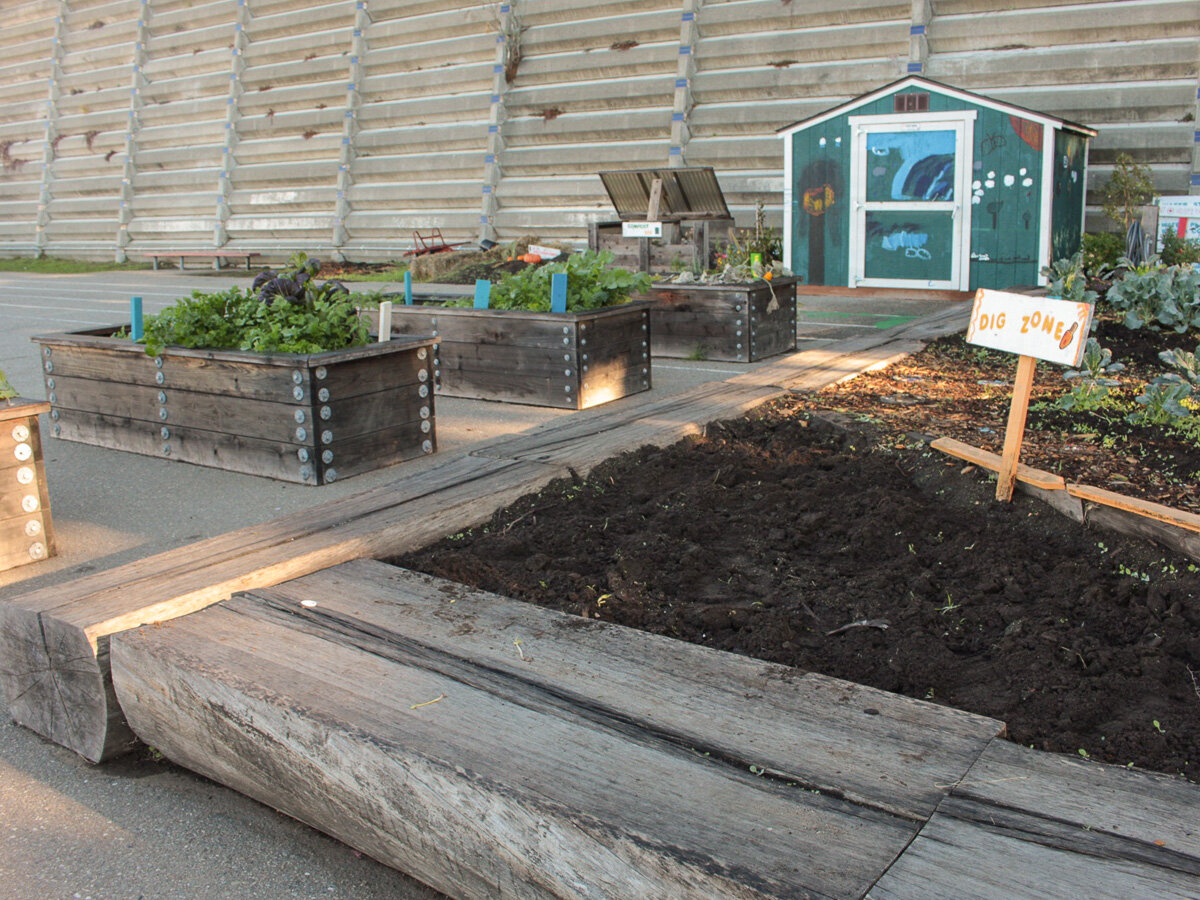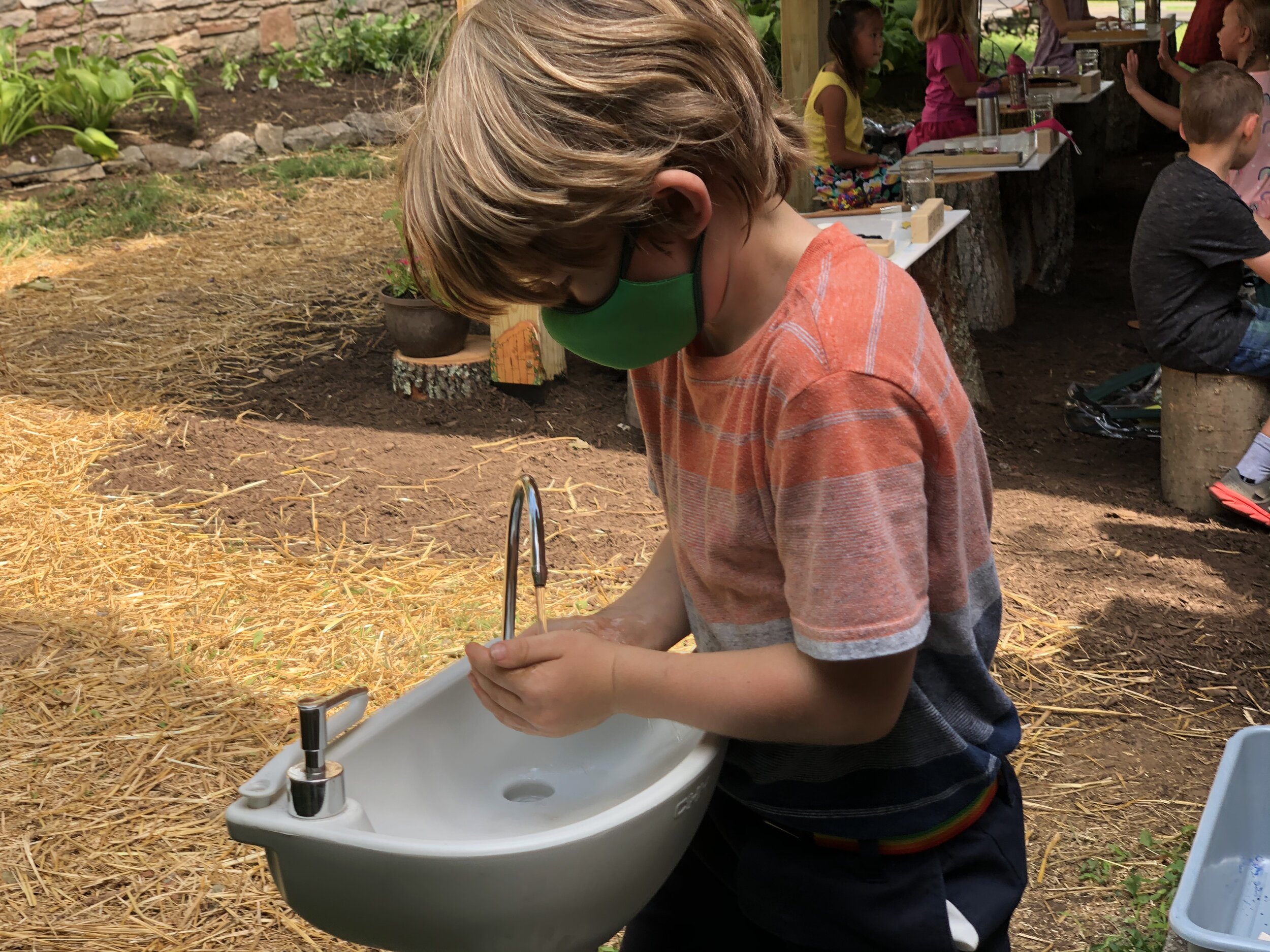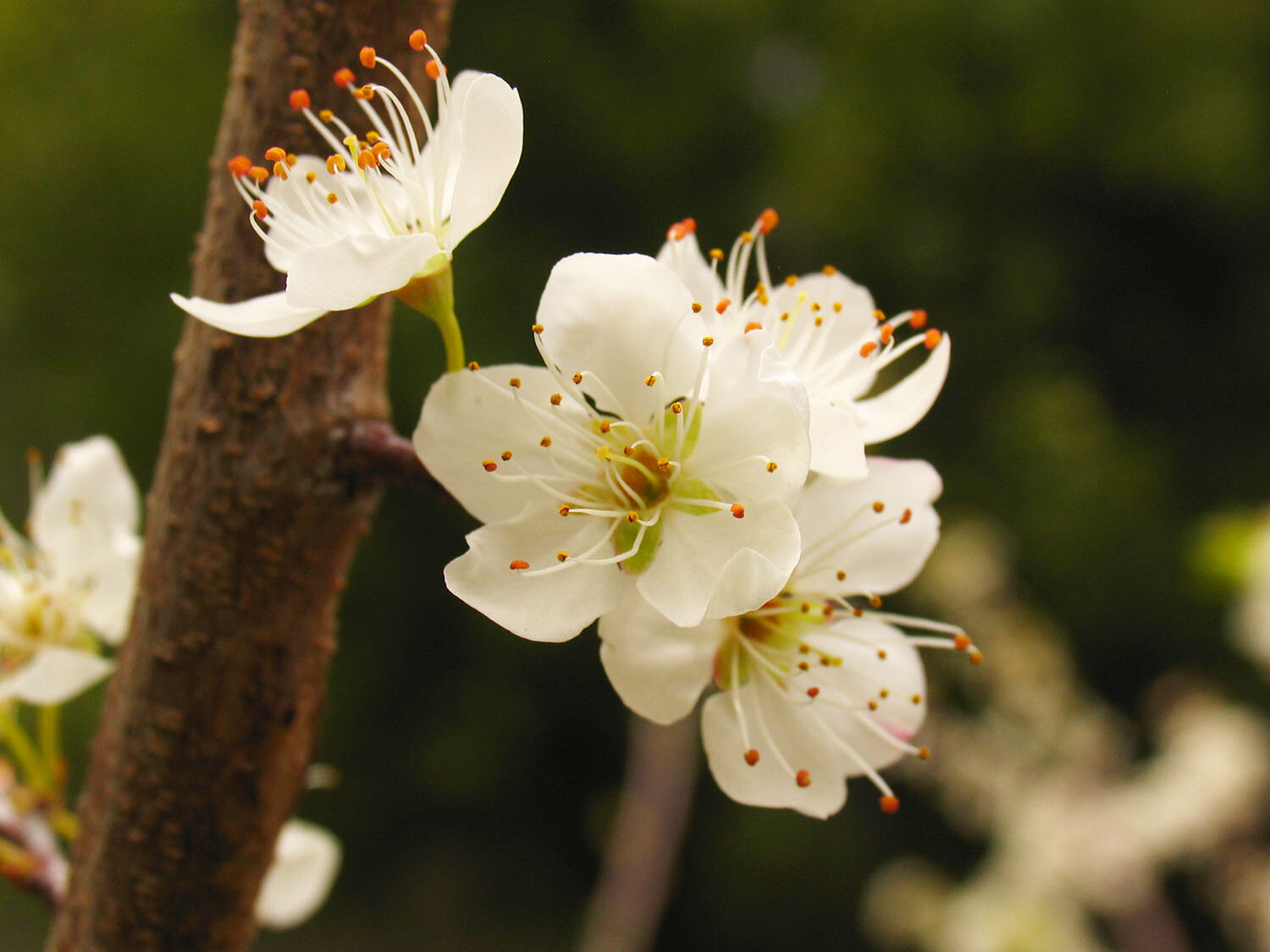CHAPTER 7
Schoolyard Design and Infrastructure
This extensive chapter of the National Outdoor Learning Library is intended to help schools and districts plan the infrastructure they will need to create outdoor learning programs. The resources in this chapter include ideas for establishing and managing outdoor classroom infrastructure and facilities to bring lessons and learning, meal service, and other school programs outdoors.
Many of the resources in this chapter were created during the pandemic to address school closures and physical distancing. Moving programs outside helped school districts across the country to stay open through the COVID-19 crisis and many found the experience so rewarding that they decided to keep part of the school day outside permanently. Schools who made investments in outdoor learning and schoolyard greening during the pandemic see that those investments can enrich education in the years to come. (For more information on the ecological benefits of schoolyard greening, see Chapter 2.)
The articles and tools featured in this reorganized version of the outdoor learning infrastructure chapter can be used to inform outdoor learning planning beyond the pandemic. The advice shared in this chapter is grounded in the collective long-term experience of our co-authors, many of whom have been working in the green schoolyard field for a decade or more and have dedicated their careers to connecting children with nature at school.
Some of the resources below include ideas for temporary outdoor classrooms and learning that are intended to be possible for a school community to implement quickly. If large-scale projects are underway or yet to be completed, these short-term changes can give the school a taste of what is to come. Other resources collected here address long term considerations for creating outdoor learning infrastructure. We hope the materials included in this chapter will help your school district — wherever you are in the planning process — to take advantage of its outdoor spaces and increase access to fresh air!
This chapter is organized according to planning phase. It opens with context and background information, as well as rationale, tools, and resources for getting started. It includes a powerful pair of articles on the why and how of green schoolyards. The subsequent sections include more detailed planning and implementation guidance related to selecting specific types of infrastructure, adapting outdoor spaces for the weather, and managing these spaces during the pandemic and beyond. This chapter also includes curated plant lists designed for outdoor learning on school grounds, organized by climate type and location within the United States. As you begin your planning process, we also recommend exploring our case study chapter to see inspiring examples from across the country that were up and running during the pandemic.
GUIDE TO SECTIONS IN CHAPTER 7
Click on the links below to navigate directly to various sections of Chapter 7, or simply scroll down to browse.
Setting the Stage
All schools and districts can take learning outside on their grounds, or into local public spaces. Our planning tools are designed with a wide range of site conditions in mind — and should serve schools and districts equally well whether they have large or small campuses, paved or park-like grounds, and snowy or balmy winter weather. We recognize that school closures due to the COVID-19 pandemic disproportionately impacted lower income and BIPOC communities, as well as students with special needs. It is vital that outdoor classroom infrastructure serve the needs of the entire school community, enabling all students and staff to experience the benefits to health, learning, and happiness that time outside can provide.
Context and Planning Considerations
Address School Infrastructure Inequity
The vast disparity in school facility investment and maintenance is one of the most visible ways that systemic inequities are expressed in the United States. This article explores equity considerations for moving learning outside.
Inclusive Design for Outdoor Spaces
Students of all abilities attend public school. It is essential to consider students with special needs from the very beginning of the planning process to ensure a universal design results.
Infrastructure Considerations for Culturally Inclusive Outdoor Learning
Outdoor classroom spaces can be customized by each school community to reflect the cultural richness, interests, and diversity of the students who will spend time in them.
(Coming soon!)
WHY CREATE LIVING SCHOOL GROUNDS
So, why create Living School Grounds? School grounds are often the main place kids spend time outdoors. Choices made by school districts about how they manage their land profoundly impacts their city and generations of local residents whose perspectives are shaped through daily outdoor experiences at school.
Investing in outdoor learning today can help to further long-term plans. Many school grounds around the country that are now lush and green were once paved — and your district can do it, too! It takes time to plan, gather the community, and fundraise but the value of having a “park” right outside the classroom door is substantial. Read about the long-term value of green schoolyards: PDF Part #1 and Part #2
Part 1 — The Green Schoolyard Movement: Gaining Momentum Around the World
Schoolyards are often one of the only places children can freely play outdoors. Creating schoolyards that foster healthy play, a sense of adventure, and a love of nature, is increasingly important.
Part 2 — The Power and Potential of Green Schoolyards
Green schoolyards foster children’s social, physical, and intellectual growth and health, while transforming barren asphalt into vibrant environments for learning and play.
Asphalt to Ecosystems: Design Ideas for Schoolyard Transformation
This comprehensive, award winning book covers transforming ordinary asphalt and grass schoolyards into vibrant ecosystems that promote hands-on learning, creative play and neighborhood ecology.
Thoughtful Planning and Implementation
As you dive into the planning process for taking learning outdoors at an individual school, there are many additional questions and consideration that arise related to the overall design and feel of the spaces you will be creating, the materials and supplies your school selects, and strategies you might consider to adapt your outdoor learning infrastructure and plans for your own climate and weather patterns.
Selecting Infrastructure for Outdoor Classrooms
There are many ways to create cost-effective, comfortable, welcoming outdoor classrooms, and there are a wide variety of materials, site furniture, and planting pallets to choose from. The articles and resources below provide an overall framework for thinking about what is best for your own school with its particular classroom and program needs, and climate context.
Outdoor Seating and Work Surfaces
A comfortable place to sit is often key to successful outdoor lessons. Portable or permanent? Natural or manufactured? We have ideas for your budget and situation.
Shade and Shelter
Open-sided shelters make outdoor spaces more comfortable and protect classes from sun and rain, increasing outdoor time. Read about materials, location, and permit rules.
Supplies and Storage for Outdoor Teaching
After setting up seating and shelter for an outdoor classroom, it is important to consider which teaching supplies are needed and how to store them conveniently. This article provides ideas and inspiration.
Making Paved Spaces Comfortable
Wondering how to make a paved schoolyard comfortable and inviting? This article offers strategies to add softness and color with art, container gardens, outdoor rugs, and more.
Using Raised Beds in Paved Schoolyards
Schools do not have to have direct access to unpaved land to add plants and gardens to their grounds. Raised beds will let you put the plants exactly where they are needed.
Weather Considerations
Outdoor learning can happen in all climates, across a very wide range of temperatures and conditions. The articles below provide tips and strategies for keeping teachers and students comfortable in different types of weather, so everyone will have a good experience outdoors.
Outdoor Learning in All Types of Weather
Cool, sunny days are a clear fit for outdoor learning, but many people are curious about what to do if it is raining, windy, hot, or cold. Read about how to select clothing and gear.
Strategies for Managing Hot Weather
How can classes stay comfortable when the weather is hot? This article shares strategies for finding and adding shade and keeping everyone well hydrated.
Strategies for Managing Cold Temperatures
What does it take to adapt outdoor learning for winter temperatures? We have some great tips and ideas to share from teachers who take their classes outside in cold climates.
Winter Schoolyard Explorations (activities)
What can you do in your schoolyard in the winter, when snow is on the ground and tree branches are bare? We would like to invite you and your school to bring your students outside for hands-on learning all winter!
Managing Outdoor Spaces
It is important to think about how your school will manage outdoor spaces as your team is creating plans for moving classes and programs outside. The articles below address some considerations that are specific to the pandemic, such as how to manage outdoor surfaces and proper sanitation outside—and frames other issues that are relevant for outdoor learning at any time, including ideas for addressing security, noise, and insects. The section also includes links to related outdoor classroom management strategies and resources for further information.
Outdoor Classroom Management
This article outlines useful strategies and tips for successful teaching and learning in an outdoor classroom.
Serving School Meals Outside
Most schools serve at least one meal or snack to students each day. Since students need to remove their masks to eat, serving meals in fresh air helps to reduce virus transmission.
Handwashing Options
Health guidance recommends frequent washing or sanitizing of hands. This article frames current recommendations and suggestions for handwashing stations for outdoor spaces.
Addressing Noise and Sound Outdoors
Outdoor spaces often include sounds of nearby traffic or construction, and children’s lively voices. This article has simple strategies to help reduce distracting noises and make it easier for everyone to hear each other.
Tips for Managing Pests
Wildlife is an important part of the natural environment. Getting accustomed to the presence of animals is a key aspect of becoming more comfortable outside. This article offers tips to address common pests.
Reducing Outdoor Allergens
Many children and adults have allergies to pollen, mold, and other materials that are naturally found outside. This article describes design and management considerations to minimize allergies during outdoor learning.
Resources
Start-up Toolkit for Schools
If you are a school looking to get started — this tool will help you visualize and plan for outdoor learning — whether you are looking for low-cost immediate options, using what you already have, or if you are planting seeds for permanent, long-term campus improvements.
District Pathway
If you are a school district just getting started with outdoor learning, this resource is designed to help you launch a district-wide program. It was written with input from district-level outdoor learning experts from across the country.
Books and Resources for Creating and Managing Outdoor Spaces for Children
The outdoor learning, green schoolyard, and nature play movements are more than thirty years old. This resource list includes more information on a wide range of related topics.
Regional Plant Lists for Children’s Environments
Plants soften outdoor environments and make them feel more comfortable and welcoming. Access to nature has also been shown to improve children’s mental and physical health and well-being, so adding plants to school grounds is not simply about beauty. Plants help to make outdoor learning spaces more effective as teaching environments by reducing students’ stress levels and helping them to pay attention. Schools can also incorporate specific plants or ecosystems into their grounds to provide hands-on teaching resources tied to standards-based curricula, and they can also select plants for their play value, wildlife habitat potential, interesting textures and shapes, and/or seasonal colors.
The plant lists in this section were developed with children’s outdoor environments in mind and include plants that are adapted to the climate of each region.
Need More Room?
Moving Outdoor Learning Offsite:
Using Public Spaces as Outdoor Classrooms
Most schools and school districts begin their planning process for outdoor learning by considering the spaces available on their own grounds, right outside their classrooms. School grounds are a logical first choice for many schools, since they are conveniently located close to teaching supplies, Wi-Fi, meal service, and other resources that are stored inside the buildings.
As schools and districts consider how to take learning outside during the pandemic, many will find their own campus cannot accommodate all of the students or programs they wish to have outdoors. In those cases, it is important to think beyond the campus boundaries, to imagine new possibilities in the wider community. Parks, public lands, closed streets, and other outdoor spaces offer valuable opportunities to extend learning into the neighborhood. We invite you to read our chapter about planning strategies for moving outdoor learning into spaces off campus.
Pandemic Planning Strategies
Outdoor Infrastructure Planning Strategies and Downloadable Tools
The section below includes articles that frame outdoor infrastructure planning strategies and logistics, and tools that will help you to assess your school’s campus, visualize outdoor classrooms on your grounds, and estimate related costs for outdoor infrastructure and supplies. Many of these resources were created during the pandemic to take into account school closures and physical distancing, yet much can be used to inform outdoor learning planning beyond the pandemic.
If your school is in the process of large-scale project that may take some time to complete, you need not delay implementing some outdoor learning strategies. Many of the resources below include ideas for temporary outdoor classrooms and learning that your school community may take advantage of while large-scale projects are underway or yet to be completed. In a sense, this can give the school a taste of what is to come.
Outdoor Infrastructure Planning Strategies
This document is a good place to start. It includes strategies to help guide outdoor classroom infrastructure development for a school or school district. Version: 12-31-20
Download PDF.
Site Analysis Considerations and Logistics Every school ground has opportunities and constraints that must be considered in a site plan, including: emergency access, ADA compliance, traffic flows, and microclimate.
Campus Assessment Tool
Download this tool before going out to walk your schoolyard. It will help you to begin your site planning process and evaluate what is needed to take learning outside.
Version: 8-13-20 Download: PDF or MS Word
Outdoor Classroom Configuration Options
Download this worksheet to estimate the size of each outdoor classroom your school will need.
Augmented Reality Visualizer (SPACINGS)
Would you like a way to visualize how an outdoor classroom will fit into your schoolyard? Use our free tool to create photographs to share your ideas.
Outdoor Infrastructure Cost Estimate Tool
Download this spreadsheet to create a cost estimate for your outdoor learning plan.
Version: 6-26-20 Download: Excel file
Planning Case Studies
The three examples below are “thought experiments” that use the planning tools above to explore a range of site planning options at three public schools located in different climates and contexts. Before you begin working on a plan for your own school site, we suggest that you download and read all three examples. Each example includes a range of site design scenarios, including low cost options. If you would like to see additional site planning examples, please visit our Emergency Schoolyard Design Volunteers page below.
Elementary School in Southern California
Very hot climate, suburban location, classroom doors open directly onto the school grounds
Elementary School
in the San Francisco Bay Area, California
Mild year-round climate, urban neighborhood, next to a park
Elementary School in Northern Virginia
Climate with four distinct seasons (very hot summers and mild, snowy winters), suburban location
Emergency Schoolyard Design Volunteer Program and Example DiagramS
The National COVID-19 Outdoor Learning Initiative was pleased to be able to provide site planning assistance to many schools and districts around the country via our Emergency Schoolyard Design Volunteers program, from June 2020 through June 2021.
The Design Volunteers program provided specialized pro bono landscape planning assistance during the pandemic, intended to help schools consider their outdoor infrastructure needs and create their first site diagrams. The diagrams conveyed each school’s outdoor learning plans and help to build consensus within a school community. Visit the design volunteer page to view an archive of real-world diagrams that volunteer students and professionals created with and for their partner schools.
Credits
The resources and strategies in this chapter were developed by the National COVID-19 Outdoor Learning Initiative’s Outdoor Infrastructure Working Group. (WG#2). This working group was led by Tamar Barlev, San Francisco Unified School District; Sharon Danks, Green Schoolyards America; Claire Latané, CalPoly Pomona; Naomi Stern, San Mateo County Office of Education; Nancy Striniste, EarlySpace; and Andra Yeghoian, San Mateo County Office of Education, and included more than fifty dedicated volunteers from around the country. We would like to express our heartfelt thanks to all of the organizations and individuals who are collaborating to make this Initiative possible.
We extend deep gratitude to Nancy Striniste and Claire Latané for their extraordinary leadership and dedication to this project.
National Outdoor Learning Library
The National Outdoor Learning Library is an expansive set of resources for schools and districts created by the National COVID-19 Outdoor Learning Initiative, which was founded in 2020 by Green Schoolyards America, The Lawrence Hall of Science, San Mateo County Office of Education, and Ten Strands. With the help of current partners, Green Schoolyards America is continuing to expand the library’s collection to support equitable access to outdoor learning and living schoolyards beyond the pandemic.











































